- News
- Reviews
- Bikes
- Components
- Bar tape & grips
- Bottom brackets
- Brake & gear cables
- Brake & STI levers
- Brake pads & spares
- Brakes
- Cassettes & freewheels
- Chains
- Chainsets & chainrings
- Derailleurs - front
- Derailleurs - rear
- Forks
- Gear levers & shifters
- Groupsets
- Handlebars & extensions
- Headsets
- Hubs
- Inner tubes
- Pedals
- Quick releases & skewers
- Saddles
- Seatposts
- Stems
- Wheels
- Tyres
- Tubeless valves
- Accessories
- Accessories - misc
- Computer mounts
- Bags
- Bar ends
- Bike bags & cases
- Bottle cages
- Bottles
- Cameras
- Car racks
- Child seats
- Computers
- Glasses
- GPS units
- Helmets
- Lights - front
- Lights - rear
- Lights - sets
- Locks
- Mirrors
- Mudguards
- Racks
- Pumps & CO2 inflators
- Puncture kits
- Reflectives
- Smart watches
- Stands and racks
- Trailers
- Clothing
- Health, fitness and nutrition
- Tools and workshop
- Miscellaneous
- Buyers Guides
- Features
- Forum
- Recommends
- Podcast
review
£2,799.00
VERDICT:
Sensibly priced, reliably specced e-road machine that shines on long, steady days out
Smooth power delivery
Decent range
Reliable specification
A little heavier than the competition
Assist button is difficult to operate
Weight:
15,200g
Contact:
At road.cc every product is thoroughly tested for as long as it takes to get a proper insight into how well it works. Our reviewers are experienced cyclists that we trust to be objective. While we strive to ensure that opinions expressed are backed up by facts, reviews are by their nature an informed opinion, not a definitive verdict. We don't intentionally try to break anything (except locks) but we do try to look for weak points in any design. The overall score is not just an average of the other scores: it reflects both a product's function and value – with value determined by how a product compares with items of similar spec, quality, and price.
What the road.cc scores meanGood scores are more common than bad, because fortunately good products are more common than bad.
- Exceptional
- Excellent
- Very Good
- Good
- Quite good
- Average
- Not so good
- Poor
- Bad
- Appalling
The Endurace:On 7.0 is Canyon's first attempt at an e-road bike, and I think it's largely a successful one. The price is palatable, it's very stable and easy to get on with, and while I found the down tube-mounted remote a bit of a pain to access, the Fazua Evation system delivers a natural-feeling boost and flattens hills to make big days in the saddle more accessible to all. Some might find the 15.2kg overall weight and easy gearing a little underwhelming, but if that's the case then e-road probably isn't for you.
Before we get into reviewing this particular bike, let's get a relatively new chestnut out the way: e-bikes (in their EU-legal guise anyway) are NOT cheating. There are actually very few occasions where you'll get a much easier day out on an e-bike than an 'acoustic' bike, one example being a long, steady gradient where you're using one of the higher assistance levels for the duration. There aren't many of those kind of climbs in the UK, so if you spend the large majority of your rides on a normal road bike averaging well over 25km/h, then you will actually be hindered when the motor cuts out because of the extra weight.
My average speeds on the Endurace:ON were mostly between 8-10% slower than my regular road rides, and trying to match my usual speed just made things quite unpleasant.
If you're someone who wants to keep up with faster friends, then e-road will be appropriate if those friends you want to keep up with average around the 25km/h (15.5mph) mark or lower. Apart from going up hills, this bike won't help you keep up with a group averaging 30km/h or more, because on the flats and slight inclines you'll just be pushing a 15kg bike instead of a sub-10kg standard road bike.
This tallies with who Canyon says the Endurace:ON is aimed at: new or less experienced road riders who want to keep up with the group, those who want to be able to ride more demanding terrain they otherwise wouldn't be able to experience, and those who prefer steadier, more consistent rides. If you think about it, a rider who simply cannot get up a 15% gradient won't be working any less hard with 250 watts of extra power; the motor is just allowing them to crest it, whereas before they'd have had to get off and push. Likewise, if an e-bike means a rider can actually spend longer in the saddle because they don't have to batter themselves whenever a hill appears, then that rider could actually get more exercise on an e-road bike.
A 2019 study published in the Transportation Research Interdisciplinary Perspectives journal supported this notion, finding that participants who rode e-bikes recorded longer trip distances than regular cyclists. If you still have a problem with any of these things then you're probably wasting your time reading this review or leaving an archetypal 'e-bikes are cheating' comment; myself and people who want an e-road bike aren't going to agree with you.
Looking for assistance?
Canyon says it wants the Endurace:ON to "level the playing field", and told me it is very much a road bike with some added assistance rather than a multi-purpose machine (despite speccing a Shimano GRX RX600 gravel groupset). While a number of bike brands launched into e-road with top-of-the-range models – such as Specialized with the stunningly expensive S-Works Turbo Creo SL at £10,999 – the Endurace:ON 7.0 has just one price and spec level. Let's not kid ourselves that £2,799 is cheap or affordable for everyone by any means, but it's good value compared to the competition and much closer to what most road riders would consider a sensible amount to spend.
Looking at the rest of Canyon's range, its standard Endurace AL Disc 7.0 model featuring a similar spec level will cost you a shade under £1,500, so to me that says you're paying just over an extra grand for the motor system and tech that comes with it. If that means being able to experience riding up Mont Ventoux when you wouldn't be able to on a regular road bike, then it's arguably worth every extra penny.
The Fazua Evation system weighs 4.6kg in total. It consists of a removable, down tube-integrated 'Drivepack' with the motor and battery in it, a remote, and a bottom bracket with an angular gearbox that offers two-sided torque measurement and a cadence sensor built in. It takes around 3.5 hours to charge fully, which you do by removing the Drivepack from the down tube by releasing a clip. On our test bike this was incredibly tight and took a fair bit of pulling, pushing and swearing to get it in and out; however, after sending it back to Canyon to be fixed it was found that a metal linkage was missing from the clip on our pre-production test bike, something that should feature on all Endurace:ONs that will be sent to customers. If you do have any issues like this then you can make use of Canyon's two-year warranty.
The Evation system has also had a bit of a revamp this year in the form of the Black Pepper firmware update, which Fazua says has primarily improved the responsiveness of the assistance, and made the cadence range better by delivering the power more consistently at high cadences (90rpm plus). Fazua also says the distinction between the power modes is more obvious; a bit more subtle on the lowest 'breeze' mode to maximise the range, and featuring a bigger kick on the highest 'Rocket' mode.
The Endurace:ON comes ready to go with Black Pepper, but the firmware update is also backwards-compatible for owners of Fazua-equipped bikes that shipped out before. The Fazua app also offers a dashboard and activity feed, and allows you to perform future firmware updates, check your battery status and tune the assistance levels, amongst other things.
Another advantage of the Fazua system is that you can actually swap out the Drivepack for a down tube cover (an optional £79.95 purchase) if you want to ride your bike without power and drop around 3.3kg of weight.
Geometry
Simply because the motor system won't fit into very small frames, the Endurace:ON AL starts with a size small (recommended for riders below 178cm, but probably not too much below) and there are only four sizes in total, compared to seven on the standard Endurace.
Looking at the geometry chart, things are a little more stretched out on a medium Endurace:ON compared to the equivalent Endurace, with a 56.7cm top tube and 39.1cm reach on my test bike compared with a 55.6cm top tube and 38.3mm of reach on a medium Endurace; to me this says it's probably best to size down if you're on the cusp.
Elsewhere, a 100cm wheelbase makes for a long, stable platform and the 15.9cm head tube gives you a more upright riding position, typical of most endurance/sportive road bikes.
Having briefly used a Fazua-equipped bike before the Black Pepper firmware update, I can't say that the improvement was immediately obvious, but as promised, the Rocket mode gives you one hell of a boost from a dead start and when you ramp it up at the bottom of a hill. When you're riding at very high or low cadences it's obvious that the assist is still being delivered consistently without any losses of power evident.
While the first generation of Fazua-equipped e-road bikes had a remote attached to the handlebar to alter the assist and turn the system on and off, the Endurace:ON has all the on-bike controls integrated into a button on the down tube, called the Remote fX. It's kind of like an electrified version of down tube shifters of yore, but instead of changing gears, you're changing your assistance level.
You press the Fazua logo in the middle to switch the motor system on and off, press at the top to go up a power level and press down to go lower. There's also a thin strip of LED dots on the right side of the button which change colour depending on your power assist level: white when it's off, green for 'Breeze' mode (100 watts of power), blue for 'River' (up to 210 watts) and red for 'Rocket' (up to 250 watts). The five LEDs also serve the purpose of telling you how much battery charge you have left: if all five are lit up it's full, and so on.
While it looks great and the buttons are very responsive, for me Fazua has taken one step forward and two steps back here – because it's almost impossible to operate the buttons without leaning out to the side because of the top tube slightly blocking your view of the button. The eBikeMotion system that features on Ribble's Endurance SL e and the Orbea Gain solves this by having the control button on the top tube, and from experience I can testify that it can be operated without really looking down too much.
When I tried to press the Remote fX without looking, I found myself going down assist levels instead of up, and vice versa. Unless Fazua goes back to the drawing board by making the button much bigger, or putting it elsewhere on the frame, I'd have to say that I'd prefer the handlebar remote option; something you can't have on the Endurace:ON, as this model only comes with the Remote fX.
Range
In terms of range, Canyon claims you'll be able to get up to 100km from a single charge using the 'Breeze' mode, and rightly says that it's kind of impossible to give a completely accurate estimate because there are so many factors – your weight, your cadence and even the temperature can all have an effect, and so it's best to just err on the side of caution if you want to get home without running out of power.
Using the assistance sparingly on a 75km ride I didn't quite run the battery dry, and I even jacked it up to Rocket mode for a few seconds on a steep hill. I estimate that I would probably have run out at around the 100km mark, which tallies with what Canyon claims and what my colleague Dave found when he reviewed the Pinarello Nytro last year.
Ride
Moving away from the electronics, the ride offered by the relaxed geometry is comfortable enough for multiple hours in the saddle, and the fact that Canyon has kept the Q factor (distance between the pedals) down to 168mm means it does just feel like an (albeit heavier) endurance road bike when pedalling.
The extra weight also means you get some extra stability when descending, which will be particularly welcome for those who are new to road riding and might feel a bit uneasy on fast descents. While the 48x11 maximum gear meant I found myself running out of gears on steep descents, I felt very planted and the extra stability meant I could descend confidently on it.
The 28mm tyres add to the comfort, and the bike appears to eat up road buzz happily and feels plenty stiff enough when you get it up to speed. While it’s not as nimble through corners as a lighter non-powered road bike, the handling is predictable and I found it easy to get on with straight away.
I did a couple of flat rides where I probably went 99% of the time without using the assistance, and I learned not to force it to avoid feeling drained by the extra heft. The Endurace:ON rides much better when you keep it steady and consistent, with my usual ‘grinding’ low cadence style not really doing much for the knees.
Finishing kit
The specification is about the same level as Canyon's other mid-level disc brake road bikes, with its aluminium H17 Ergobar AL and V15 stem making for a sturdy and reasonably lightweight cockpit.
The wheels are courtesy of Alexrims, and are a custom OEM spec made specifically for Canyon based on its tubeless-ready RXD3 wheelset. When I got the bike I figured these wheels might be a cost-cutting measure compared to the DT Swiss training wheels that appear on most of Canyon's alloy road bikes, but to ride they felt sturdy, dependable and plenty stiff enough to cope with the load; if anything, they're an upgrade compared with the wheels that come with the standard alloy Endurace models.
They roll on 28mm Schwalbe E-One Evolution tyres, which I ran with tubes for the test period without any issues. They're perfectly appropriate for the bike with adequate grip – if a little heavy – and I've no doubt they'd prove extremely durable.
I didn't really care for the Iridium Fitness saddle because I prefer a cutout, and swapped it for my Pro Stealth for most of the test period. That's personal preference of course, but popping it on my scales I also discovered the Iridium weighed in at a whopping 355g; just by swapping for my Pro Stealth I got the bike under 15kg, and while that's rather high-end it wouldn't have hurt to spec a lighter, sportier saddle to save a few grams in my opinion.
The 15.2kg heft of our size medium bike is the kind of weight where you really notice the difference compared to a standard light road bike, both when you're riding or attempting to carry/lift it. It means it's not ideal to run out of battery power during a hilly ride like I did on one occasion, although the 11-speed 11-42t cassette paired with a 48-tooth single chainring up front gives you plenty of lower gearing options, albeit with some bigger jumps between gears than on 2x groupsets.
If you're just looking for the lightest e-road bike around at this price point then the Endurace:ON isn't it; the Ribble SL e mentioned previously, to give one example, is under 12kg.
Value
In terms of value and how it compares with what else is out there... well, it's probably the most affordable Fazua-equipped e-road bike I've come across, and there's not much that can beat it for value. The Fazua-powered Pinarello Nytro, as mentioned above and reviewed by eBikeTips last year, comes in at £6,000, but that has a carbon frame and a more luxurious spec.
> Read more e-bike reviews at ebiketips
There are more affordable options featuring the eBikeMotion system, including Ribble's Sl e that costs the same as the Endurace:ON with a Shimano Tiagra groupset, and the Orbea Gain that starts at £1,999 with 8-speed gearing.
Fazua says its system offers more torque at a claimed 60Nm compared with a claimed 40Nm on eBikeMotion, so it could be argued that Evation is the more powerful of the two motor systems.
Conclusion
To summarise, I found the Endurace:ON to be a solid entry into e-road for Canyon, and it's an impressively affordable package. If you’re looking for an e-bike that really does just feel like a normal road bike to ride for the most part, then it’s a solid option. It isn't necessarily a bike I would buy myself at the moment, but I definitely think this and e-road bikes like it have a place in the market.
Heading out for a steady cruise on the Endurace:ON never failed to make me happy, so long as I wasn't expecting to be gunning it around like I would on a very light, non-powered racing bike. If Canyon could offer a version with Fazua's handlebar control instead of the awkward down tube remote, that would make me even happier.
Verdict
Sensibly priced, reliably specced e-road machine that shines on long, steady days out
road.cc test report
Make and model: Canyon Endurace ON 7.0
Size tested: M
About the bike
List the components used to build up the bike.
Canyon lists:
Frame: Canyon Endurace:ON
Fork: Canyon FK0074 CF Disc
Motor: Fazua Evation 1.0
Battery: Fazua Evation 1.0 250 Wh
Rear Derailleur: Shimano GRX RX812 GS
Cassette: Shimano SLX M7000 11-42 11s
Crank: Samox EC38 48T
Chain: KMC X11-93
Brake levers: Shimano GRX RX600
Brake rotors: Shimano RT70
Wheels: Alexrims RXD5C
Tyres: Schwalbe E-One Evolution 28mm
Handlebar: Canyon H17 Ergobar AL
Stem: Canyon V15
Saddle: Iridium Fitness
Tell us what the bike is for and who it's aimed at. What do the manufacturers say about it? How does that compare to your own feelings about the bike?
Canyon says: "At Canyon, our goal is a simple one: to democratise performance. That's why we're so proud to announce our first e-road bike, the Endurace:ON. A bike that levels the playing field for everyone, and breaks down barriers to experiencing great road rides. Riders who want to enjoy are more controlled form of exercise. Riders fresh to the sport who want to keep up with the bunch. Riders who seek a little extra support to keep getting out into challenging terrain. Now, they can all carry on doing what they love, where they love doing it."
Where does this model sit in the range? Tell us briefly about the cheaper options and the more expensive options
There is only this one model and one spec option.
Frame and fork
Overall rating for frame and fork
7/10
Tell us about the build quality and finish of the frame and fork?
It's an alloy endurance road bike frame with smooth welds and a discrete, earthy paint job. The battery is integrated into the down tube, so to the untrained eye it doesn't really look like an e-bike.
Tell us about the materials used in the frame and fork?
Aluminium frame, carbon fork.
Tell us about the geometry of the frame and fork?
It's built around the geometry of Canyon's standard Endurace, more relaxed than its Ultimate and Aeroad models.
On a size medium:
Top tube: 56.7cm
Seat tube: 52cm
Head tube: 15.9cm
Wheelbase: 100cm
Stack: 59.5cm
Reach: 39.1cm
Chainstay: 42.5cm
Head angle: 73°
Seat angle: 73.5°
How was the bike in terms of height and reach? How did it compare to other bikes of the same stated size?
It has slightly more stack and reach than a standard size medium Endurace.
Riding the bike
Was the bike comfortable to ride? Tell us how you felt about the ride quality.
Very comfortable: it's not an aggressive bike and is best for relaxed, steady riding.
Did the bike feel stiff in the right places? Did any part of the bike feel too stiff or too flexible?
Plenty stiff enough, everything's solid.
How did the bike transfer power? Did it feel efficient?
When the motor cuts out it's quite draggy and quite tough to get up to speed, but that's mostly because of the extra weight.
Was there any toe-clip overlap with the front wheel? If so was it a problem?
No.
How would you describe the steering? Was it lively neutral or unresponsive? Neutral.
Tell us some more about the handling. How did the bike feel overall? Did it do particular things well or badly?
Just because of the extra weight it feels a bit more stable downhill, and the handling is predictable at all times.
Which components had the most effect (good or bad) on the bike's comfort? would you recommend any changes?
The 28mm tyres and carbon fork add to the comfort. Nothing really makes it uncomfortable.
Which components had the most effect (good or bad) on the bike's stiffness? would you recommend any changes?
The alloy components give a decent amount of stiffness for the price point.
Which components had the most effect (good or bad) on the bike's efficiency? would you recommend any changes?
Lighter wheels might help.
Rate the bike for efficiency of power transfer:
7/10
Rate the bike for acceleration:
9/10
The motor obviously makes it accelerate better than most road bikes!
Rate the bike for sprinting:
6/10
Not really a bike for sprinting.
Rate the bike for high speed stability:
8/10
Rate the bike for cruising speed stability:
9/10
It's in its element here.
Rate the bike for low speed stability:
9/10
And here.
Rate the bike for flat cornering:
8/10
Rate the bike for cornering on descents:
8/10
Rate the bike for climbing:
9/10
It's got a motor, so obviously that helps...
The drivetrain
Rate the drivetrain for performance:
7/10
Reliable, middling components, mostly from Shimano, that do the job.
Rate the drivetrain for durability:
7/10
Rate the drivetrain for weight:
7/10
Rate the drivetrain for value:
8/10
Tell us some more about the drivetrain. Anything you particularly did or didn't like? Any components which didn't work well together?
Solid and reliable; 1x also makes it easier to maintain.
Wheels and tyres
Rate the wheels for performance:
8/10
Rate the wheels for durability:
8/10
Rate the wheels for weight:
8/10
Rate the wheels for comfort:
7/10
Rate the wheels for value:
7/10
Tell us some more about the wheels.Did they work well in the conditions you encountered? Would you change the wheels? If so what for?
The Alexrims wheels are comparable to the DT Swiss training wheels that come on a lot of Canyon's other mid-priced road bikes, and felt sturdy and dependable through the test period.
Rate the tyres for performance:
7/10
Rate the tyres for durability:
7/10
Rate the tyres for weight:
7/10
Rate the tyres for comfort:
8/10
Rate the tyres for value:
7/10
Tell us some more about the tyres. Did they work well in the conditions you encountered? Would you change the tyres? If so what for?
The tyres were fine for me, ideal for all-weather road riding and plenty durable.
Controls
Rate the controls for performance:
7/10
Rate the controls for durability:
7/10
Rate the controls for weight:
7/10
Rate the controls for comfort:
7/10
Rate the controls for value:
7/10
Anything else you want to say about the componentry? Comment on any other components (good or bad)
The saddle is unnecessarily heavy and wasn't to my liking, but otherwise it's a solid spec list. The 1x gravel gearing might seem odd on a road bike but it's appropriate for e-road.
Your summary
Did you enjoy riding the bike? Yes
Would you consider buying the bike? No
Would you recommend the bike to a friend? Yes
How does the price compare to that of similar bikes in the market, including ones recently tested on road.cc?
It costs much less than the average e-road bike, with Fazua-equipped options such as the Pinarello Nytro costing £6,000; I've not seen an e-road bike featuring the Fazua system for less. Ribble's Sl e featuring the eBikeMotion motor system also costs £2,799, while the eBikeMotion-equipped Orbea Gain is cheaper, starting at £1,999.
Rate the bike overall for performance:
7/10
Rate the bike overall for value:
9/10
Use this box to explain your overall score
The standout feature is really the price, and while nothing on the spec list blows you away, it's appropriate for a more affordable e-road bike. The awkward position of the Fazua control button and the extra weight compared to similarly priced competitors prevents the score from edging higher.
About the tester
Age: 27
I usually ride: Road bike (currently Specialized Tarmac) My best bike is: Ridley Chronus TT bike
I've been riding for: Under 5 years I ride: Every day I would class myself as: Experienced
I regularly do the following types of riding: road racing, time trialling, commuting, club rides, sportives, general fitness riding, Triathlon races
Jack has been writing about cycling and multisport for over a decade, arriving at road.cc via 220 Triathlon Magazine in 2017. He worked across all areas of the website including tech, news and video, and also contributed to eBikeTips before being named Editor of road.cc in 2021 (much to his surprise). Jack has been hooked on cycling since his student days, and currently has a Trek 1.2 for winter riding, a beloved Bickerton folding bike for getting around town and an extra beloved custom Ridley Helium SLX for fantasising about going fast in his stable. Jack has never won a bike race, but does have a master's degree in print journalism and two Guinness World Records for pogo sticking (it's a long story).
Latest Comments
- newbankgyratory 2 sec ago
This website offers suitable data: https://www.automobiledimension.com/large-suv-4x4-cars.php
- newbankgyratory 32 min 56 sec ago
Perhaps park the goods in a US Customs Bonded warehouse and then import them out of there when the tariff nonsense settles down?...
- Dnnnnnn 41 min 27 sec ago
Good to see a road.cc review of what must be one of the UK's best-selling 'proper' road bikes. 6/10 feels a little harsh though: the tyres could be...
- PRSboy 1 hour 27 min ago
Another thing ruined by the Americans
- Miller 2 hours 46 min ago
Nice to see WvA featuring in the finale.
- Miller 2 hours 49 min ago
I have known more than one elder statesman of the club die of a heart failure while out on a ride. Sometimes I feel that's about to happen to me,...
- Pub bike 3 hours 7 min ago
Via the "wireless active steering system".
- Hirsute 3 hours 30 min ago
137m is the farthest I have observed when quickly looking at the Garmin unit....
- pockstone 3 hours 47 min ago
Yours worked wonders, but if you insist, I'll hop to it...why the need for extra police? Did the fire brigade bottle it?
- Jamminatrix 4 hours 1 min ago
As if Tadej Pogacar's slavery-supporting jersey is any different...




























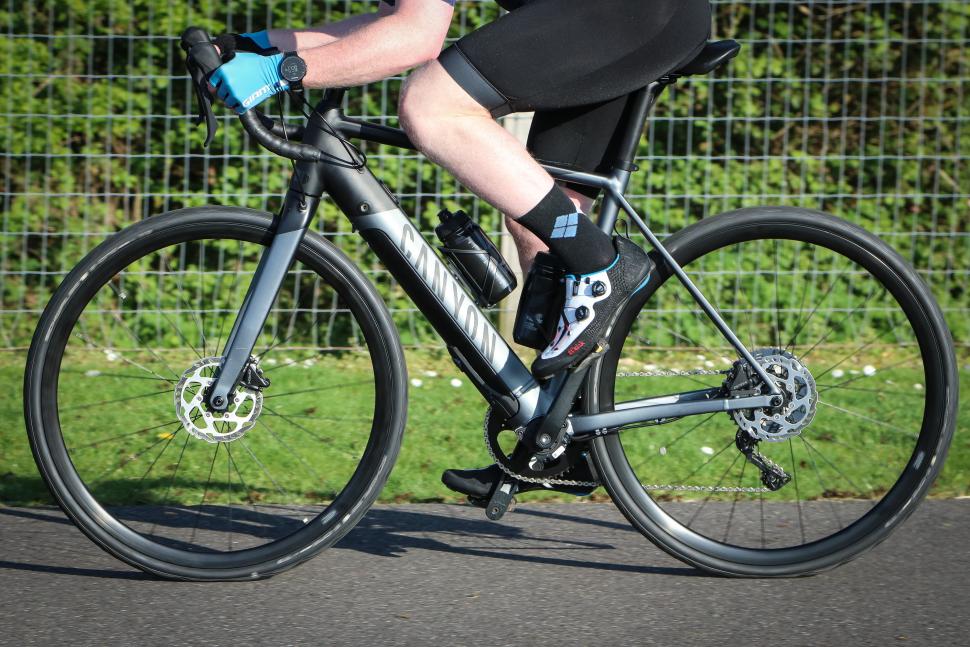
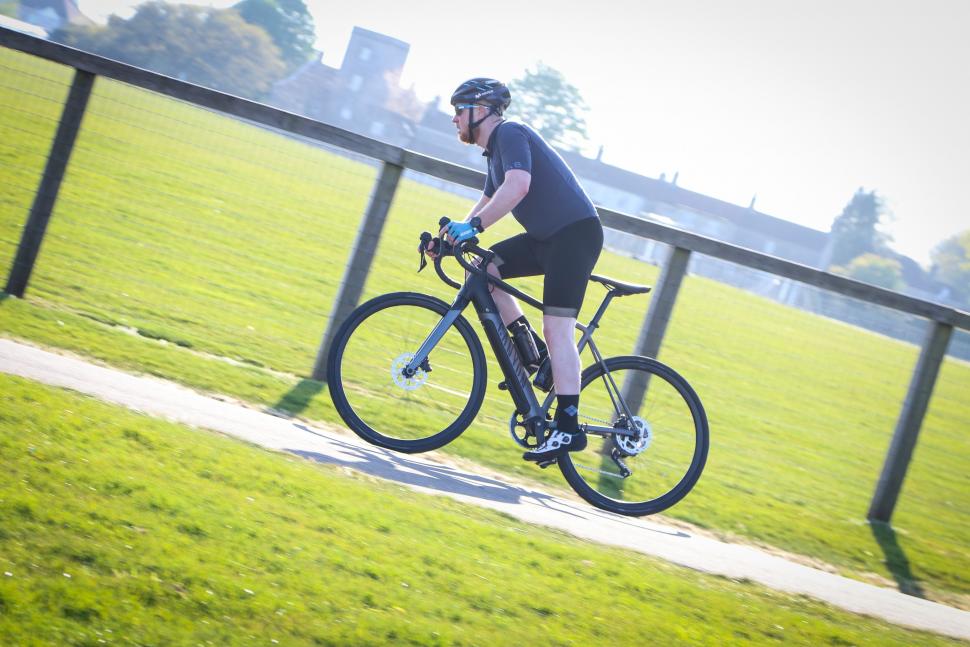
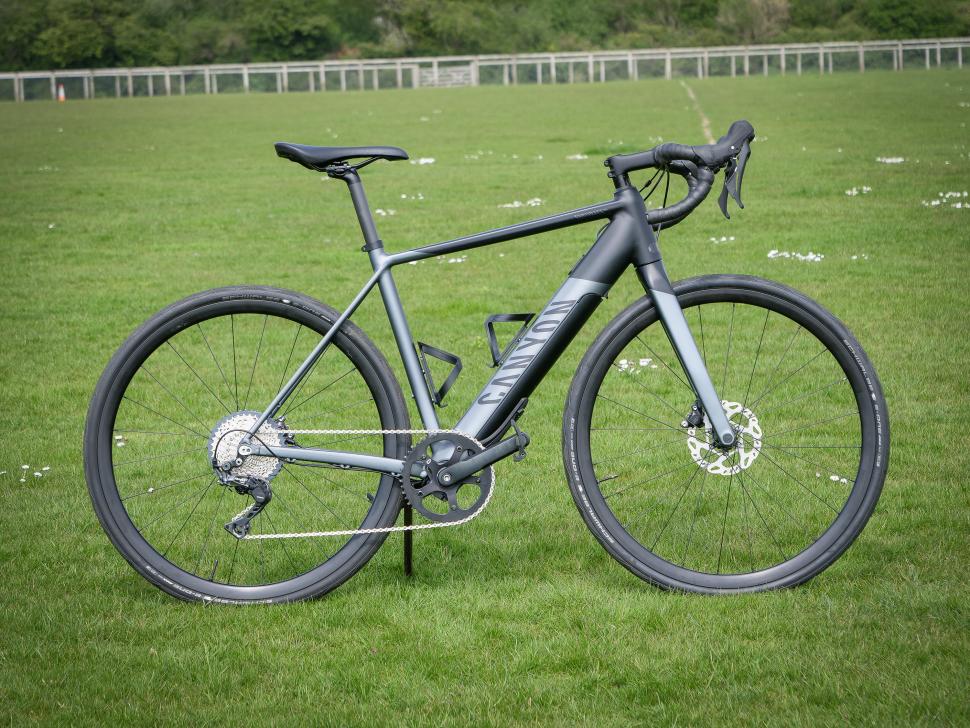


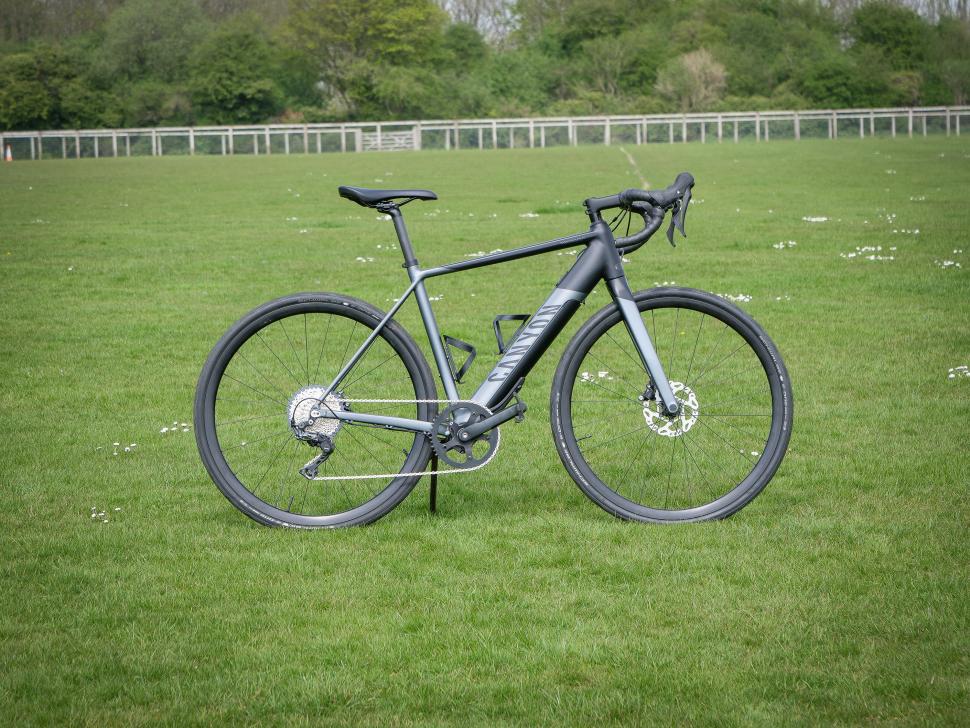



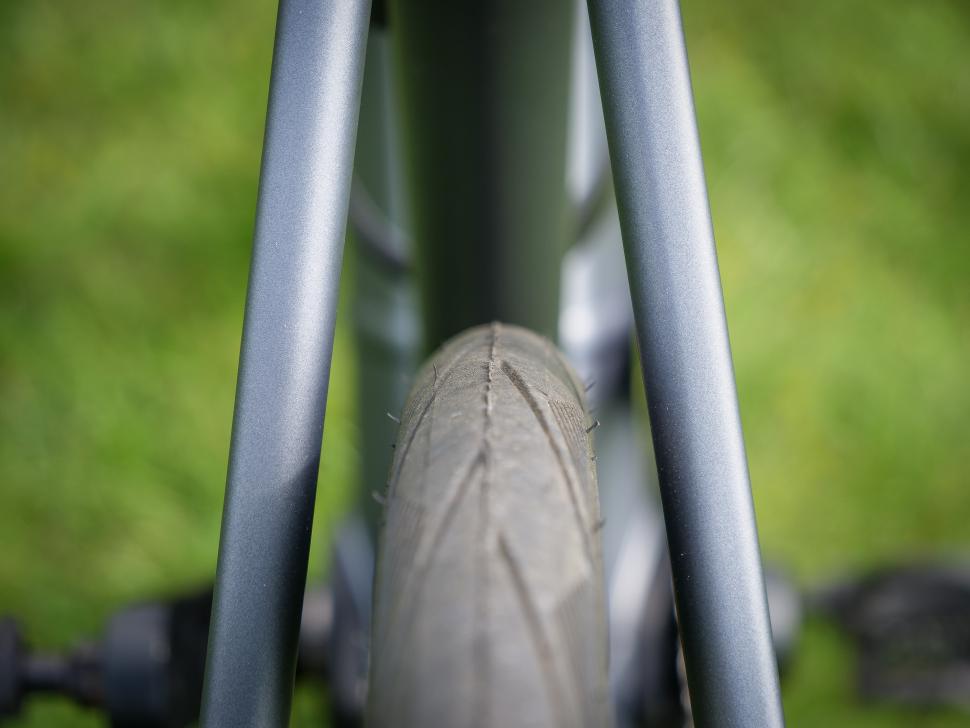




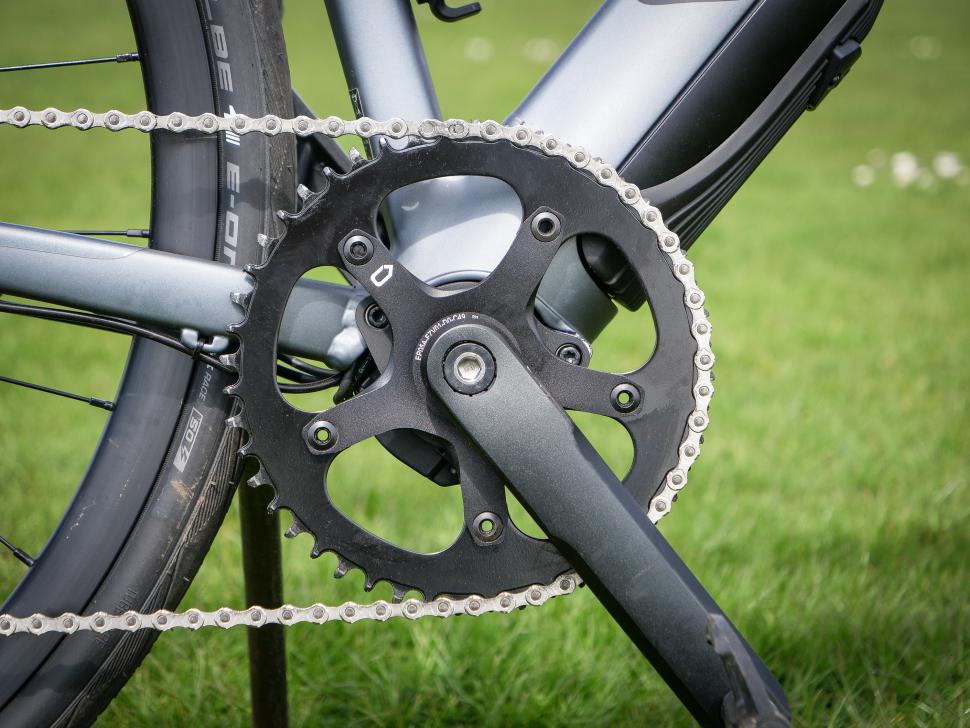
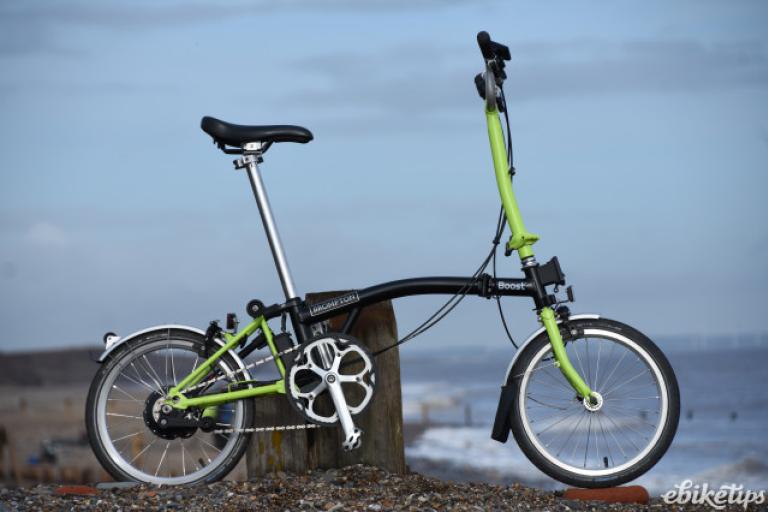
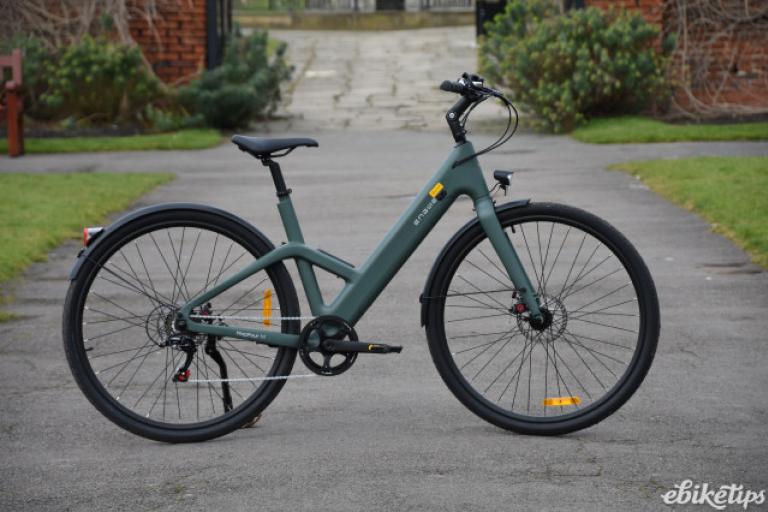
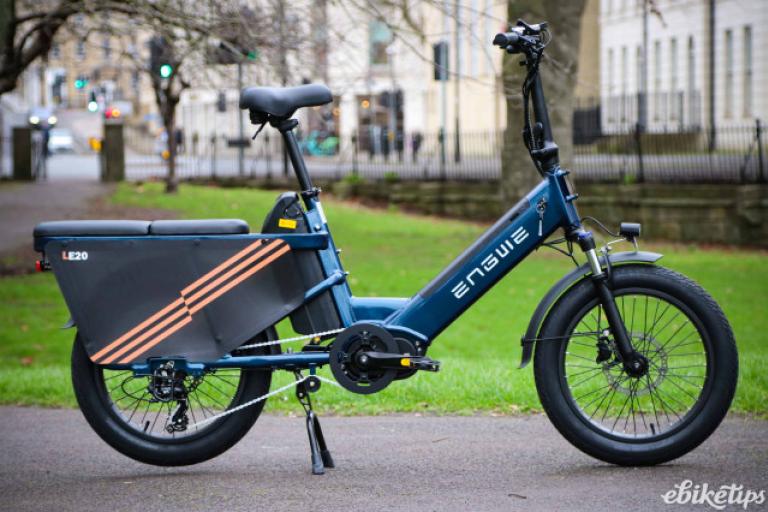
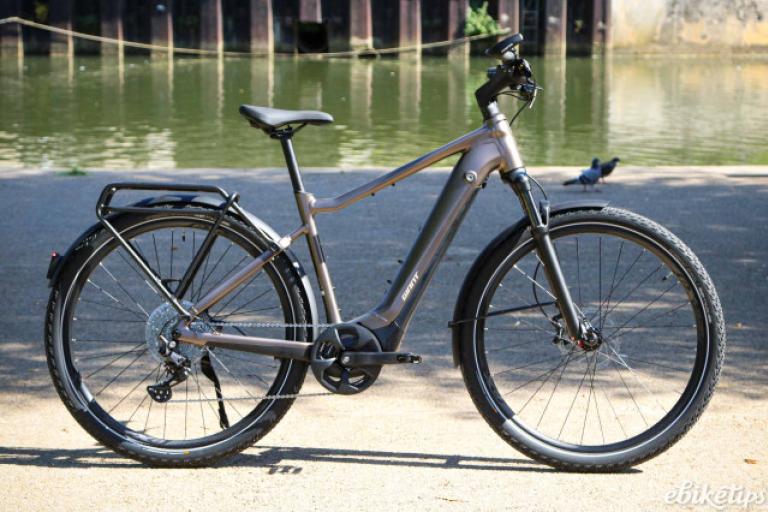
Add new comment
3 comments
OK, review, but I'm not sure you really liked the bike or the point of e-bikes. Ask someone like Sean Yates about the benefit of e-bikes. And what about the cheaper Boardman ADV 8.9e or for about a grand more, the Focus Paralane2?
Given that the Ebikemotion rear hub powered bikes such as the Ribbles are so much lighter, yet come with the same capacity battery, you start to wonder why this one weighs so much: although this seems churlish compared to the reported 20+ kg of some other e-road efforts (Giant for example). A bit more torque from the motor sounds great but in e-road bikes the principle is you should only be using the assistance part-time anyway, and as soon as the bike becomes too heavy for that to be true, you might as well go the whole hog and have a 'heavy' ebike with the hugest battery so you're using the assistance full-time.
I'm sure you are right. But nevertheless the whole bike comes at a weight penalty of just over 6.5kg compared to the Endurace AL Disc 7.0. Would it be fair to say the demands of the Fazua system overall weigh 6.5kg, rather than just the 4.6kg weight of the bits?